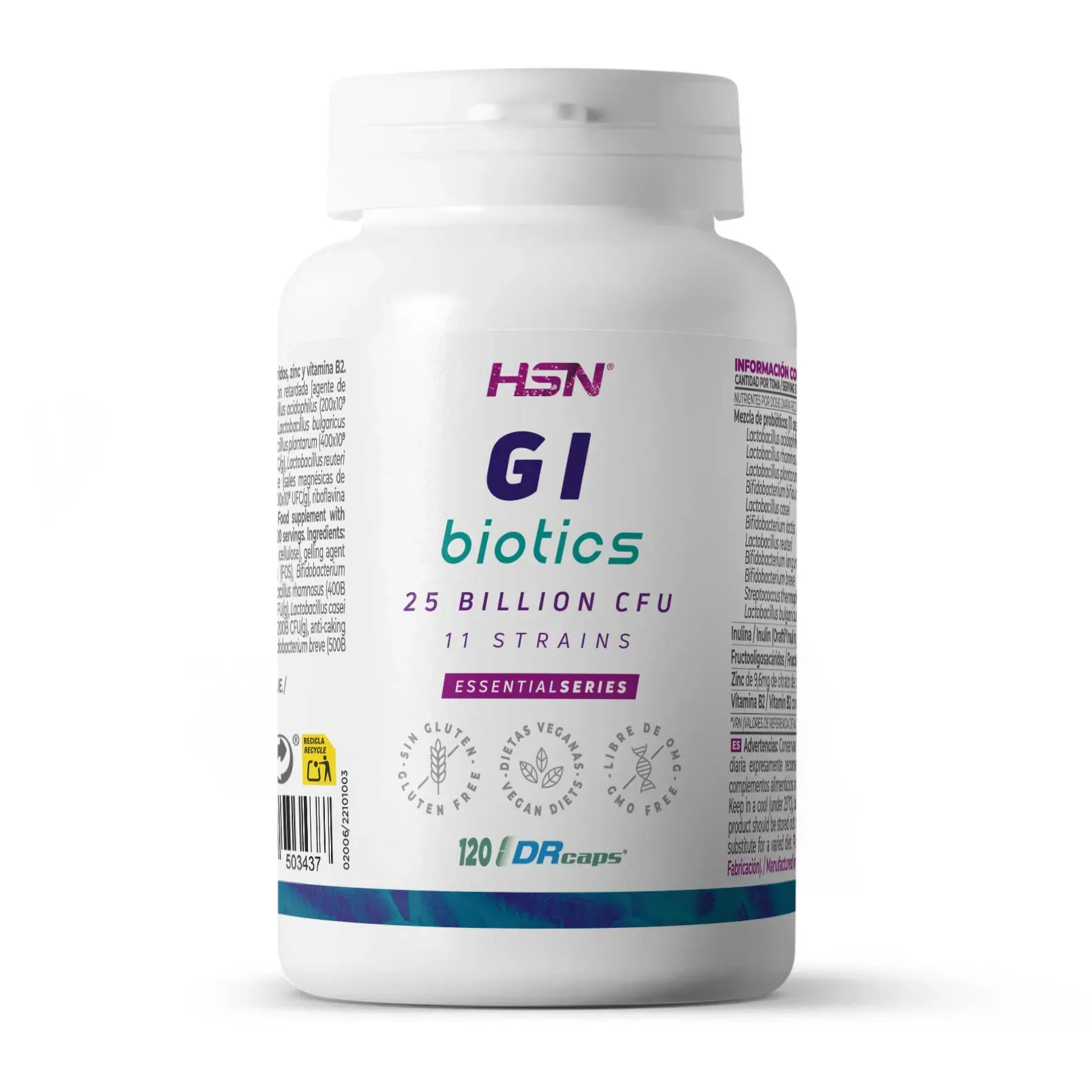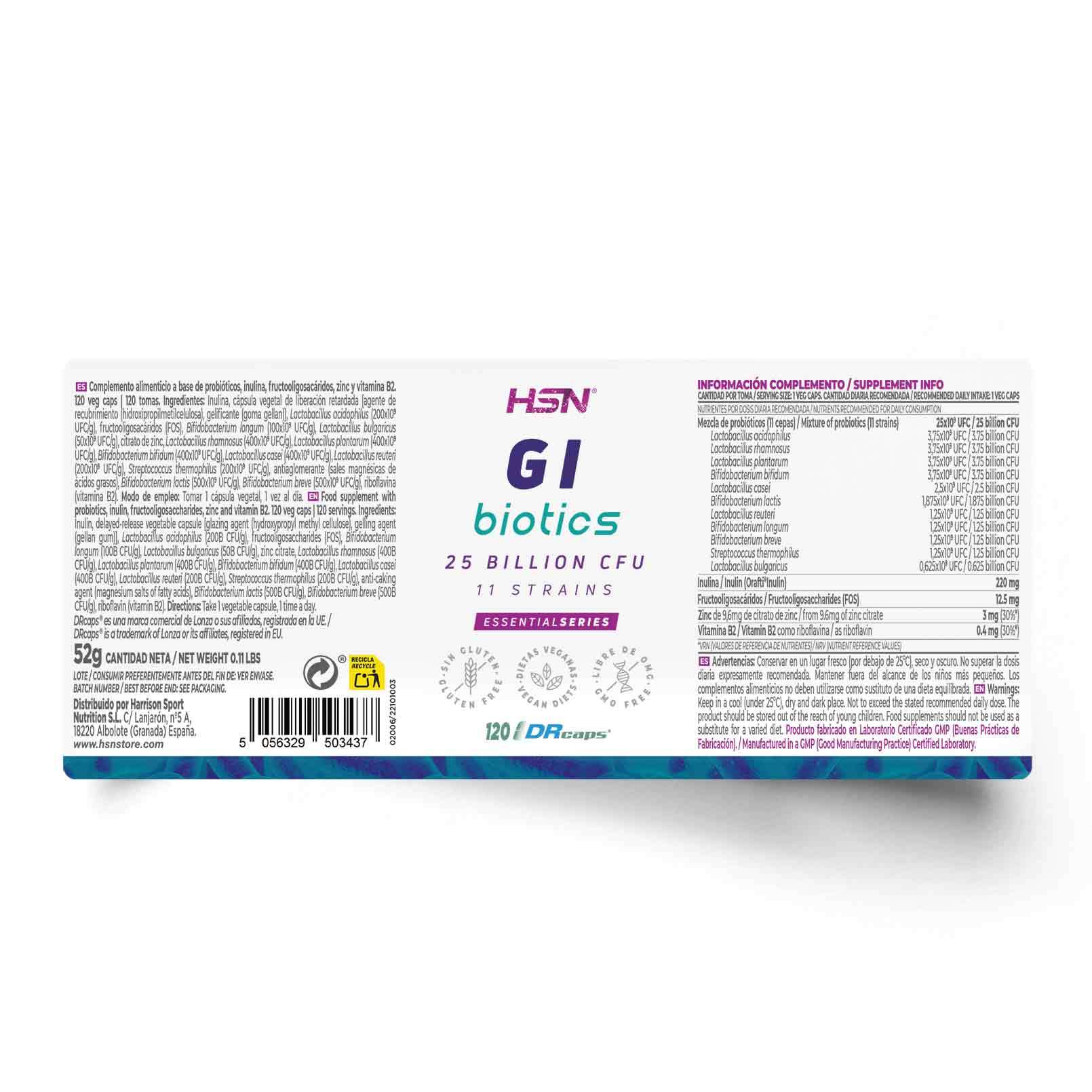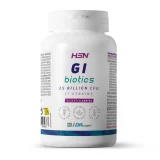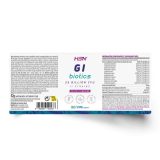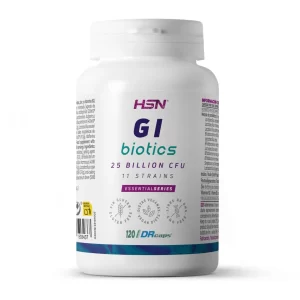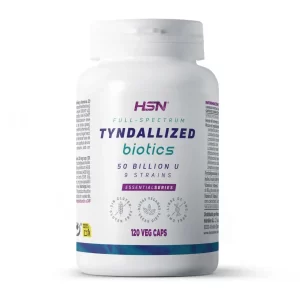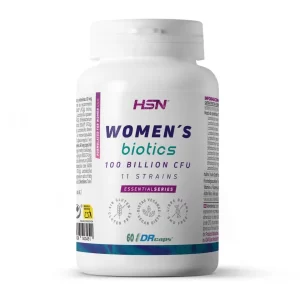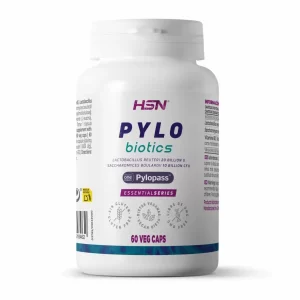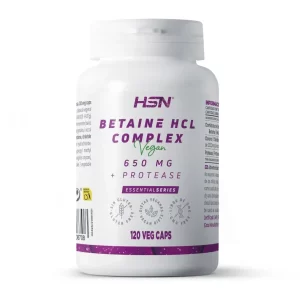- GI (Gastrointestinal) Formula – Intestinal Probiotics from HSN.
- Presentation of 25B (Billion) Colony Forming Units (CFU).
- Probiotics from non-animal sources – Suitable for vegetarian and vegan diets.
- Probiotic strains cultivated in an unfavorable environment to achieve the survival of the best.
- Encapsulated with DRcaps® – Vegan gastro-resistant delayed-release coating.
- Choose 25B for maintenance, continuation, or general use in the long term.

GI Biotics Probiotics 25B CFU – The most classic formula
GI Biotics Probiotics 25B CFU from EssentialSeries is our most ‘one for all’ probiotic formula, and it’s usually the best choice for all those who are unsure which of our ‘Biotics’ options to choose. GI Biotics is formulated with a blend of probiotic cultures with 11 different strains, with a total biological activity of 25 billion colony-forming units guaranteed, combined with Inulin, FOS, Zinc, and Vitamin B2 (riboflavin).
GI Biotics is HSN’s most digestive formula, designed to exert a specific action on the gastrointestinal system thanks to the presence of zinc in its composition, which helps with the normal metabolism of macronutrients. It has been developed with a specific combination of probiotic strains from the families: Streptococcus, Lactobacillus, and Bifidobacterium. In addition to the presence of prebiotic fibers such as fructooligosaccharides (FOS) and fructans (inulin).
25B CFU is not a quantity value but an activity value, the correct way to measure the effectiveness of a probiotic formula. Our 25B CFU are guaranteed until the end of the product’s shelf life, unlike probiotics from other brands.
Discover GI Biotics – What makes it unique?
CFU. Understand its importance
Probiotics are microbes, and they must be alive.
The term ‘probiotic,’ as defined by the Spanish Agency for Food Safety and Nutrition:
Refers to bacterial species, bacterial strains, or species of live microorganisms, such as Lactobacillus helveticus, Lactobacillus rhamnosus, etc.
And for this to be properly fulfilled, the selected bacterial strains in the probiotic formula must be alive, and therefore their biological activity (Colony Forming Units) must be known. However, many companies market products based on probiotics where they only declare the milligrams of the powder containing the bacteria used, which while practical in terms of development, is unspecific and unidentifiable for the effectiveness of the formula’s use by users, what if the bacteria have died in the powder? What does the quantity matter if there are no ‘live probiotics’?
To avoid these problems, at HSN we indicate the correct value, the one that should be reflected in any probiotic product so that you can really know its effectiveness and what concentration we are talking about: Colony Forming Units in the body ‘CFU’. Any probiotic you acquire, whether it’s a single strain or a mixture of several species, must indicate the units of bacteria it contains so that you can choose the best product accurately according to your needs.
25B CFU is an appropriate concentration for chronic, long-term use of a probiotic formula for maintenance purposes and without special requirements, a matter we address further in this description.
Specific selection of bacterial strains
Not all probiotics are the same, and we’re not talking about probiotics as products, but about bacterial strains.
‘Probiotic’ is a very broad term, there are hundreds of bacteria whose consumption in humans is generally recognized as safe and therefore usable in food and dietary supplements, however, how do we know which strains are useful or beneficial?

We know this through scientific studies that different researchers from multiple universities around the world carry out with a large number of people, for weeks or even months, and that establish which bacteria specifically possess certain types of properties, which others, and which do not have physiological properties beneficial to the human body.
HSN’s GI Biotics formula has been developed after reviewing the most current and significant scientific evidence on probiotics for use as a dietary supplement, and we have chosen a selection of 11 bacterial strains from the most recognized families of probiotic bacteria in nutrition: Lactobacillus, Bifidobacterium, and Streptococcus.
You will find well-known strains such as L. Acidophilus, L. Casei, L. Reuteri, or B. Bifidum, among others.
Cultured Ferments
Probiotics are bacteria that grow in specific environments; they should not be confused with probiotic bacteria intended to colonize the host and exert their nutritional properties, with bacteria that naturally develop from food decomposition; although both types are bacteria, some are beneficial and others harmful to humans, and ultimately, they have nothing to do with each other.
The bacteria used as probiotics in our Biotics range are ferments that have grown in media controlled by biochemistry specialists, in order to properly multiply until reaching billions of units in controlled environments and thus maximize all their beneficial effects.
Many companies acquire probiotics that have been cultured by specialists in favorable environments; this is the simplest since if all the necessary external conditions for the development of a probiotic are provided, it will multiply rapidly and easily, but its resistance to the environment is lower. These types of probiotics need refrigeration, are very delicate, and die very quickly and easily. In short, they are effective presentations of probiotics while they remain alive, but their viability is greatly reduced.
At HSN, we have selected the development conditions for our probiotics, and we have established a culture medium considered ‘non-optimal’ for their growth. This does not negatively affect their effectiveness; on the contrary, it is more costly for the manufacturer since the bacteria develop worse. However, they are much more resistant to the environment because they have already survived a difficult culture medium; thus, our bacteria do not require special care, refrigeration, or specific control of any environmental condition, and their biological activity remains intact throughout the product’s use.
Probiotic / Synbiotic – The Role of Prebiotics
Probiotics are a term that is clearly defined as live bacterial strains ingested to colonize the host and exert their nutritional functions in it. However, during the conceptualization of the term ‘probiotic,’ a parallel concept emerged called ‘prebiotic,’ which categorizes a type of fiber with particular nutritional properties and is recommended in combination with probiotics.
The combination of probiotic + prebiotic is called synbiotic and is considered a formulation superior to either class of compounds separately.
In HSN’s biotics formulas, we add prebiotics to our specific selections of probiotics; you will find a mixture of inulin and fructooligosaccharides in HSN’s GI Biotics.
DR Caps® – What They Are and Why They Revolutionize HSN Probiotics
Many research studies have focused on determining the nutritional kinetics of probiotics, and many of them have reached the same conclusion: Bacteria do not survive at low pH levels.
Our probiotics are pH-resistant, due to the adverse cultivation conditions in which they have been produced. As such, they are capable of coming into contact with stomach acids without degrading. However, we have decided to provide an extra protection system in our latest reformulation: DR Caps®.
DR Caps® is a trademark registered and patented by Lonza, a prestigious Swiss company, currently expanded across all regions of the world, specialized in the development of coating agents and active ingredient handling in the food, dietary supplement, and pharmaceutical industries.

DR Caps® is the name given to their development of vegetable capsules with gastro-resistant protection or enteric coating. The use of these capsules allows the digestive passage of GI Biotics to occur without the probiotics coming into contact with digestive acids, as the capsule remains intact and does not release its content in the stomach, unlike other encapsulated forms. Once it reaches the intestine, where the environment is more basic, suitable for the survival of probiotics, and where studies indicate that probiotics must reach for their proper nutritional performance; the capsules dissolve and release their contents, exactly where you want them to.

HSN Biotics Do Not Require Refrigeration
One of the most delicate issues with probiotics that renders many options available in the market ineffective due to lack of biological activity is the cold chain.
Probiotics that have been cultivated favorably have grown under controlled temperature conditions, refrigerated, and for their survival require the maintenance of these conditions, something that poses a clear logistical difficulty at various points in the process:
- The manufacturing: Although probiotic developers have the industrial conditions required for cold processing, dietary supplement factories (final product), often do not, so if the manufacturing of the supplement you receive at home is carried out by handling the probiotic powder without refrigeration conditions, it is not effective.
- The shipping: Although there are increasingly more tools for shipping orders under refrigeration conditions, it remains a challenging process that increases the cost of the product to the customer.
- Home storage: Keeping probiotics in the refrigerator, taking up space, is objectively worse than being able to store them at room temperature.
However, with HSN, you can do it; our probiotics survive at ambient temperatures since they have been cultured with these temperatures, not in cold conditions, thus allowing their natural environment to be the ambient temperature. With this, we achieve: more resistant probiotics, without the need to care for the cold chain throughout the production and storage process, both on our part and yours at home, and without cost to your purchase due to the necessary conditions to maintain this.
A Maintenance Formula – How to Combine it with 100B CFU?
In addition to GI Biotics 25B, we have a version 4 times more concentrated: 100B CFU, does this mean that 100B CFU is better than 25B CFU?
No, each concentration is suitable for different purposes, each having a place in the diet of the person using probiotics, depending on the moment.
25B CFU is considered the usual amount of probiotics you should use to take advantage of their nutritional properties, on a daily basis, in the long term, and without special considerations; whereas 100B CFU is a probiotic intended for specific uses, at specific times when you need that extra concentration, or in people with particular needs that require such high concentration chronically.
A common way to use probiotics at one of the most common times for their intake, which is: After a drug treatment with antibiotics, consists of using GI Biotics 100B CFU for 60 days (2 months, the duration of one container) and once finished, continuing the intake of probiotics with the 25B CFU version for another 120 days (4 months, the duration of one container). For a total usage time of 6 months.
Once this period is over, the cycle can be repeated, continued with the maintenance dose of 25B, or stopped according to needs.
Can Probiotics Be Taken with Other Products?
Yes.
Probiotics are compatible with each and every one of the compounds commonly used as dietary supplements; they can be used together (including in the same intake) with:
- Vitamins.
- Minerals.
- Plant Extracts.
- Amino Acids.
- Creatine.
And of course, along with proteins, carbohydrates, isotonics, mass gainers, and any other powder, capsules, or tablets you can buy at HSN, so you can use GI Biotics completely calmly along with these products.
Scientific References on Probiotics
- Sanders, M. E., Guarner, F., Guerrant, R., Holt, P. R., Quigley, E. M. M., Sartor, R. B., … Mayer, E. A. (2013). An update on the use and investigation of probiotics in health and disease. Gut, 62(5), 787–796.
- Shing, C. M., Peake, J. M., Lim, C. L., Briskey, D., Walsh, N. P., Fortes, M. B., … Vitetta, L. (2014). Effects of probiotics supplementation on gastrointestinal permeability, inflammation and exercise performance in the heat. European Journal of Applied Physiology, 114(1), 93–103.
- Hempel, S., Newberry, S. J., Maher, A. R., Wang, Z., Miles, J. N. V., Shanman, R., … Shekelle, P. G. (2012). Probiotics for the prevention and treatment of antibiotic-associated diarrhea: A systematic review and meta-analysis. JAMA – Journal of the American Medical Association, 307(18), 1959–1969.
- McFarland, L. V. (2007). Meta-analysis of probiotics for the prevention of traveler’s diarrhea. Travel Medicine and Infectious Disease, 5(2 SPEC. ISS.), 97–105.
- Jäger, R., Mohr, A. E., Carpenter, K. C., Kerksick, C. M., Purpura, M., Moussa, A., … Antonio, J. (2019). International Society of Sports Nutrition Position Stand: Probiotics. Journal of the International Society of Sports Nutrition, 16(1), 62.
- Wilkins, T., & Sequoia, J. (2017). Probiotics for Gastrointestinal Conditions: A Summary of the Evidence. American Family Physician, 96(3), 170–178.

